 Your new post is loading...
 Your new post is loading...
Sometimes it feels like the 1970s in the New York Times and Washington Post newsrooms: reporters battling each other to break news about scandals that threaten to envelop the White House and the presidency of Donald Trump. Only now their scoops come not in the morning edition but in a tweet or iPhone alert near the end of the day.
It is like old times in another way: both newspapers are getting readers to pay, offsetting advertising revenue relinquished to the internet. After years of giving away scoops for nothing online, and cutting staff, the Times and Post are focusing on subscriptions—mostly digital ones—which now rake in more money than ads do.
Their experiences offer lessons for the industry in America, although only a handful of newspapers have a chance at matching their success. A subscription-first approach relies on tapping a national and international market of hundreds of millions of educated English-language readers and converting a fraction of those into paying customers. With enough digital subscribers—Mark Thompson, chief executive of the New York Times, believes his newspaper can get to 10m, from 2m today—the subscriptions-first model could (in theory) generate more profits than business models dependent on print advertising used to.
As if the newspaper business didn’t have enough trouble already, the position of “newspaper reporter” has been named the single worst job in the United States – again.
The extremely dubious honor was conferred on the beleaguered industry by CareerCast, which offers job listings in local and niche job markets. While it’s probably not much comfort, a number of other traditional media careers are also in the doghouse.
According to CareerCast’s list of the 400 best and worst jobs, newspaper reporter came in at the very bottom with a median salary of $37,200 for a print reporter, plus a negative growth outlook for the industry of -9%....
...Are you planning projects that member outlets would be able to incorporate into their own websites? Absolutely! All of our interactives are embeddable, and our members and customers already incorporate them into their sites. I’m interested in ways we can customize our data-driven interactives, both for the customer and for the end user. Those efforts are part of our design discussion for the work we’re doing now. I would also like to find more ways to collaborate with other news organizations. AP was born from such cooperation, and it is an important part of our identity. Are the projects the AP works on more often than not driven from the print side, augmenting what’s being written by a reporter or team of reporters? Or do they sometimes originate from the digital side? If it is a case of digitally driving what reporters write, would you like to see a shift to data journalists promoting more original narrative work? More often than not, I’ve found that good data projects start with solid shoe-leather reporting, so most of our data projects have begun with the work of text reporters and editors. But the data work that we do begins before the story is written: exploratory data analysis can discover new angles in the data, and the right visualization can reveal a trend we had missed. We’re really moving away from the model in which visualization or interactive storytelling is an afterthought, an illustration of the story, and toward a model in which this work is central to developing the story and enables us to tell the story in ways impossible for straight text reporting....
The media industry may be hurting, but journalism -- and access to information -- is flourishing. Journalists may just have to work smarter, and network more, to keep up.... Journalism is not in crisis. The media industry — and journalists — might be, but the journalism itself is actually improving. Such is the argument made by international documentary filmmaker Bregtje van der Haak and Annenberg professors Michael Parks and Manuel Castells in a recently published article about “Networked Journalism.” As the authors see it, the problem is that most of the doomsayers mix the concept of journalism with the business of journalism. In their article, journalism is defined as the “production of reliable information and analysis needed for the adequate performance of a democratic society.” Not mentioned in the definition are “profits,” “professional journalists” or “traditional publishers.” Just the pursuit of reliable information....
Guardian digital development editor Joanna Geary answers some questions about GuardianWitness.... ...First up: this was built in two months. The sponsorship pot from EE gave them a budget and time to get the job done, but not necessarily have everything they wanted at launch. She says it's a complete, working system that can be built upon. I suggest the phrase "minimum viable product" to Jo but she suggests that it's a full product - one that will be built on. Do they have aspirations for more integration with social media? Yes, they do. And it's something they're looking at as the system develops. The key part of the development which is invisible to us right now is that the Guardian Witness system is deeply integrated with the Guardian's CMS. Once the content has passed through verification, it's available to the journalists, and they can insert it into a story or liveblog just by inserting an URL, which creates an embedded version of the contribution that links back to the contributor's profile. "The really exciting thing is not what you see now, but what you see when Witness is included in a story," she says. It's a tool to facilitate genuine collaborative working between the journalist and external witnesses. Jo says they'll collaborate with people on the ground, or with expert knowledge, in any way they can - and already do, via phone and other traditional methods. This adds another tool for doing that....
Terrible events such as yesterday’s bombings at the Boston Marathon have always meant “all hands on deck” for news organizations, with staffers pulled off their regular beats to contribute. But the endpoint of the newsgathering and reporting is no longer a front-page package of stories explaining — the best one can — what happened, why it happened and what might be next. Now, there is no endpoint — events are reported in real time, with stories in constant motion, and the front page is a snapshot of an organization’s reporting at the moment when the presses needed to roll. Boston was a reminder of that, and a look at what’s changing in real-time journalism. Through Twitter and various live blogs, I found myself looking over my shoulder at the Boston Globe, the New York Times, Reuters and other news organizations, and was able to make some observations and draw some conclusions....
A round up of all the best insights from the live Q&A, which explored how alternative news sites platforms interact with mainstream news sites... The internet has enabled the proliferation of alternative news sites, such as blogs and community news platforms, providing consumers with a variety of perspectives. In our recent live Q&A, we explored what role these news platforms play in breaking news and how far they impact mainstream news reporting. Here is a selection of views from our recent live Q&A looking at the relationship between alternative news platforms and mainstream news sites.... Great insight... more local, more video, more activism, more news...
Every 30 seconds or so, an algorithm developed by Narrative Science produces a computer-written news story, Wired reports. The articles run on the websites of respected publishers like Forbes, as well as other Internet media powers (many of which are keeping their identities private). Niche news services hire Narrative Science to write updates for their subscribers, be they sports fans, small-cap investors, or fast-food franchise owners. And the articles don’t read like robots wrote them....
Don't be fooled by evangelists of 'free': editorial ethics and real reporting have been blown up along with the business model. Over at Slate the other day, Matthew Yglesias argued that journalism consumers are enjoying a "golden age". Yeah, sort of – in exactly the way looters enjoy an improved standard of living. Problem is, it only stays improved until the store is emptied out.
The news industry has gone from being obscenely profitable to slightly profitable to – at least, in the case of newspapers – largely unprofitable. All of that fantastic content Yglesias was gushing about is paid for by venture capitalists making bad bets, established media companies digging into their savings accounts to pay the bills, displaced workers earning peanuts, amateurs, semi-pros, volunteers and monks.
I would say that the business model is unsustainable, but losing money is not a business model. It is a going-out-of-business model....
When Facebook introduced its redesigned News Feed, it did more than change how people view memes and photos of cats — it altered the way stories are seen. Now everyone can make news. But for those who make a living by spreading news, Facebook has changed the way stories are presented. Dean Praetorius, a senior editor with The Huffington Post, talked with AllFacebook about how the way news is presented on Facebook requires some changes to the traditional approach. The Huffington Post has recently been lauded for its popularity on Facebook. Pew Research Center presented findings regarding news and social media, citing a study by Newswhip showing that the online newspaper was by far the most engaged news source on Facebook. In terms of Facebook interactions, HuffPost beat out more traditional companies, such as The Daily Mail, The New York Times, and CNN. How did HuffPost accomplish this? Praetorius said that the company has taken a well-rounded approach to social media, knowing that the story is far from completed when it’s published. HuffPost also thinks about stories differently from print media outlets and TV stations. Praetorius said that stories on the site are meant to generate conversation, and not so much to simply inform, as an old-school newspaper would...
If the newspaper industry had theme music in 2013, it might use “Been down so long it looks like up to me,” the much-recycled line from a 1920s blues song. For the first time since the deep recession that began in 2007, newspaper organizations have grounds for a modicum of optimism... Companies have started to experiment in a big way with a variety of new revenue streams and major organizational changes. Some of the bright opportunities – such as offering social marketing services to local businesses – are ventures too new to be measured yet industry-wide. They show signs of stabilizing revenue.... Even halting improvement in the general economy helps the industry. The double whammy of cyclical ad losses on top of secular shift to new media has considerably eased from the worst of the recession from 2007 to 2010. Auto advertising has come back, and some markets, like Miami, are beginning to see recovery in real estate and employment ads as well. All those positives, however, are for the time being mostly promise rather than performance. The most basic indicators have not turned around. The industry is little more than half the size it once was. Considerable dangers persist... So the industry entered 2013 with some positive signs but still dealing with difficult economic realities. The two biggest newspaper developments of the last year – digital paywalls and reduced print frequency – capture that odd mix of expansion and contraction now typical within the industry....
As the news industry looks to reconstruct its suffering business model, the journalists of today must reconstruct their skill sets for the growing world of online media. Because of cutbacks at many news organizations, the jobs available are highly competitive. News companies are seeking journalists who are jacks of all trades, yet still masters of one (or more). 2010 will likely be a time of transition as today's journalists catch up to learn the multimedia, programming, social media, and business skills they'll need to tell their stories online. These new skills are especially relevant to startups that are looking to hire multi-skilled and social media-savvy journalists. Below we've gathered some skills that are quickly becoming basic requirements for the journalist of tomorrow. These skills are presented in no particular order....
IN JANUARY the New York Times lost its top spot in comScore's ranking of the world's biggest newspaper websites to Britain's Daily Mail. The Times sniffed at the accuracy of comScore's figures, which exaggerate the Mail's online audience by including a personal-finance site that the paper owns. But the battle to be biggest reflects a growing phenomenon: national news publications going global. A mere one-quarter of the Mail's online readers are in Britain. The Guardian, which caters to those who like their news left-leaning and serious in contrast to the Mail's right-wing raciness, has one-third in Britain and another third in America (see charts). Their chief competitors are two American publications: the New York Times, which like the Guardian aims at readers of serious news, and the Huffington Post, which since its launch in 2005 has become the biggest site of the four (it is not in comScore's “newspaper” category). That the HuffPo is beating papers with a history stretching back to the 19th century is a sign of just how differently news works online....
|
I’ll admit that I’ve previously been skeptical about ideas of digital detoxes and media fasts. Instead, I’ve subscribed to Clay Shirky’s maxim: “It’s not information overload, it’s filter failure.” But, last week, whilst attending the 2017 International Journalism Festival in Perugia, Italy, I began to change my mind. Sitting in a beautiful, cool, stone courtyard, sipping espresso and surrounded by promotional material for a local Slow Food festival, I began to sketch out some thoughts for a panel on Slow News that I had been asked to contribute to. Ensconced in this relaxing environment, I quickly identified several reasons why news consumers, content creators and managers, could all benefit from taking their foot off the gas… Just a little bit....
Evan Williams sees Medium, the blogging platform that he and Biz Stone launched last year, as a modern-day magazine. When Twitter cofounders Evan Williams and Biz Stone launched Medium last year, their goal was for it to be a collaborative publishing tool that connected writers to a larger network. But that vision also hinges on quality, curation and, in some ways, a higher barrier to entry than platforms like Twitter. “We’re going to be a great place for professional writers to write,” Williams told Wired senior writer Steven Levy at the Wired Business Conference in New York on Tuesday. “The magazine is the analog for what we’re doing.”
April was a big month for breaking news, and that meant strong ratings for CNN. Fox News led the pack as usual. It was the second most watched network in all of cable, drawing 2.02 million total viewers in primetime and 389,000 in the key 25-54 demo. Overall, the network was up nine percent in total viewers and down two percent in adults 25-54. The bigger story, however, was CNN, which pulled ahead of MSNBC for the number two spot for the first time in months. April was full of big news stories — from the Boston marathon bombings to the fertilizer plant explosion in Texas — and the ratings proved that breaking news is still the network's bread and butter....
Traditional news organizations need to embrace the disruption brought by digital culture -- or they risk becoming obsolete. That was the message late last week at the International Symposium on Online Journalism hosted by the Knight Center for Journalism in the Americas at the University of Texas at Austin, where about 370 of the world's journalists, researchers and media watchers grappled with the hard questions for a beleaguered traditional media industry that is now more than a decade into its disruptive transformation. The problem is many media companies view digital technologies through a lens of traditional journalism and thus, fail to strategize properly, said Clark Gilbert, president and CEO of Deseret News Publishing Company. "In a post-disruption world, why would people pick up a paper at all? Why would someone turn on the 10 o'clock newscast?" Gilbert asked. "If you are not asking those fundamental questions, there is not a future for you legacy organization." The key to surviving? Innovate. Fail. Innovate again....
Natural disasters, airline crashes — and yes, terrorist bombs — undercut the normalcy of everyday life by bringing death’s whammy to an unexpected place at an unforeseen time. In the hours and days following such catastrophes, journalists work to restore normalcy to the panicked population by explaining how and why the bad thing happened and how to prevent it from happening again. Reporters have been normalizing the abnormal for so long that they’ve created well-worn catastrophe templates to convey their stories. Yesterday, while covering the Boston Marathon bombing, journalists leaned hard again on those templates. First came the sputtering dispatches over radio and television about the calamity. Next up were the on-the-scene broadcast reports, frequently marred by confusion and contradiction, as the press held out hope for survivors but prepared audiences for the worst. Video of the catastrophe was converted by the cable news networks into a perpetual loop, giving the talking heads a wallpaper background to talk over (and giving new viewers just tuning in something graphic to watch)....
Today’s annual report on the State of the News Media shows that new technologies really are pressing journalists to do much more with much less. Last week, we learned that newspaper industry ad revenue was down 7.3 percent this year to its lowest level since 1984 (or 1954, adjusted for inflation). As a result, newsrooms continue to shrink. But The Project For Excellence in Journalism’s report shows us that the needs and demands of the audience are growing and fragmenting. Social media is an important source of news, the report says, but remains smaller and only “supplemental” to other discovery methods like directly visiting a news website, searching the Web or browsing an aggregator....
...At their core, Facebook, Tumblr, and Twitter are sharing networks, not publishing companies. They act as platforms for other people’s content, which can be spread rapidly and massively among their communities. A consequence of being walled gardens that restricts this sharing activity within their own properties, however, is that they give up the right to decide when and how that content breaks free into the wider public discourse. Even though it had success with its partnerships program at placing stories into other forums, Storyboard’s stories always had the whiff of marketing, or what is these days being described as “native advertising.” As we now know, that ultimately did not work out for Tumblr. Going by Fletcher’s comments, perhaps Facebook Stories will meet a similar fate....
A little more than a year ago, BuzzFeed made the leap into the realm of serious journalism. It hired some known journalists and a lot more hungry young writers, expanded its verticals, and announced a plan to create serious content to go alongside the site’s trademark clever lists. Now, with BuzzFeed creating a home for its long reads, building a business vertical and trying to figure out how to expand into breaking and international news, it’s a good time to assess....
WorldStream, the Journal's stream of brief videos built on Tout, is getting premium ad rates and substantial audience numbers. The text-based web is dead, says Michael Downing. When AOL CEO Tim Armstrong announced his intention this month to transform the company into a platform for video, Downing heard a death knell — one he’s been expecting for some time. We are, after all, as he says, on the precipice of “the rise of the visual web.” Downing has a dog in this fight; he’s the founder of Tout, a video sharing website and app that makes it easy for users to upload and share short — under 15 seconds — videos in real-time. Although originally designed as a consumer device, it also appealed to publishers: The Wall Street Journal approached Downing with the idea for a proprietary app that reporters could use as a news gathering tool. With the addition of some analytics tools and a centralized management function that allows editors to quickly vet clips before they’re published, that became WorldStream, which we wrote about in August....
Alternative weekly colossus Boston Phoenix cracked and fell this week, ceasing publication after 47 years. Once one of the leading alt-weeklies in the nation, the dead paper leaves behind $1.2 million in debt and roughly $500,000 in assets. ...The advertising shift from newsprint to Web is mirrored by a cultural shift. In my mind, the alt-weekly remains the perfect boredom-alleviation device. Waiting for a subway train? Pull one from your bag and it will entertain you. Your girlfriend is late for your date? The paper will keep you occupied. That beer and bag of nuts not distracting from life’s troubles as you mope on a barstool? The alt-weekly saves the day again. But even a human fossil must concede that the smartphone trumps the alt-weekly as a boredom killer. How does a wedge of newsprint compete with an affordable messaging device that ferries games, social media apps, calendars, news, feature films, scores, coupons and a library’s worth of music and reading material? Ask a young person his opinion and he’ll tell you that nothing says “geezer” like a newspaper, be it daily or alt-weekly. What’s changed, and what probably convinced the Phoenix to exit, is that the papers are no longer a 30 percent (or higher) margin business, and that lost business is not returning. Publishers who hope to survive will have to content themselves with 10 percent margins. They will have to work harder to maintain advertising categories where they still have a comparative advertising advantage, such as food and restaurants, which usually require a face-to-face meeting between an ad representative and an owner to make a sale. It’s a cliché, but I’ll toss it out there anyway: Every newspaper and website needs to compete in the events business. The smarter papers are already there, and if they’re lucky they’ll hit the jackpot the Austin Chronicle has with its decades-old SXSW business. And it doesn’t require much insight to urge alt-weekly publishers to continue building out their Web components....
The grizzled vet and the digital native: Journalism has plenty of room for both to succeed. I spent eight years at AOL and I'll say this: I saw none of the great, all of the bad and some of the good. ... The blood sport during my AOL days was about the future of media companies — who would or wouldn’t survive the digital onslaught. Actually, it was much the same during my time at Newsweek in the 80s (who needed three newsweeklies in a broadcast world). Ditto when I joined The New York Times in the 70s (was the city big enough for both The Post and Daily News). Now, the social Web with its echo chamber turns up the volume daily — and makes it more personal, too. It’s far more about the fate of the individual journalist. That quickly gets down to the paycheck. Will there be one? How much? Who gets it — the “professional” or the pretender? Consumer demand for credible news and information is greater than ever. The problem is the 100-year-old model for producing it is forever broken. That’s why more attention must be paid to finding new ways to produce quality journalism — efficiently, at scale and at a price supported by mobile CPMs, which at best are 50% lower than desktop CPMs, which if you’re lucky come in two-thirds lower than print CPMs. In other words, a high-cost newsroom structure built for the print age will never work in a smartphone or tablet world. A few startups are experimenting with new models — Vox Media, Machinima, Bleacher Report and Storify are a few that I follow. Among traditional media companies, FORBES is the only one I know of charting a new course....
Bill Keller obviously has something of a love/hate relationship with the internet. The former New York Times executive editor has written columns questioning the societal value of Twitter and web news aggregators like the Huffington Post. On the other hand, he’s rather active on Twitter, where he has more than 50,000 followers, and it was under his tenure that the Times became an enthusiastic user of that platform, among a slew of other digital technologies. And now he’s officially a new media guru, having been a speaker at SXSW Interactive in Austin this week. Keller, who’s been writing for the Times’s Op-Ed page since handing over the top job to Jill Abramson in 2011, was a guest on a panel about digital bullying. After that discussion, I caught up with him for coffee and a chat. When I asked if it was okay to record our conversation, he quipped, “That depends what you’re going to ask me.”...
|
 Your new post is loading...
Your new post is loading...
 Your new post is loading...
Your new post is loading...




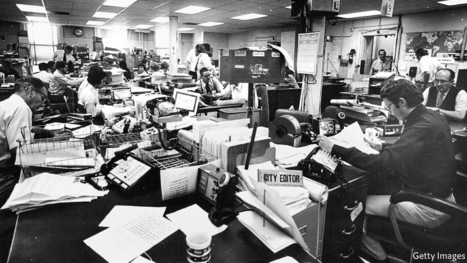



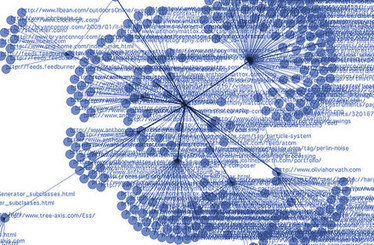



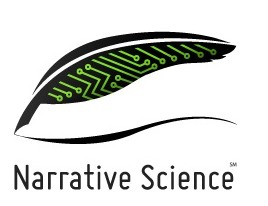

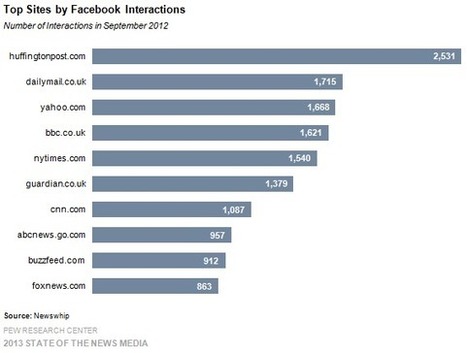
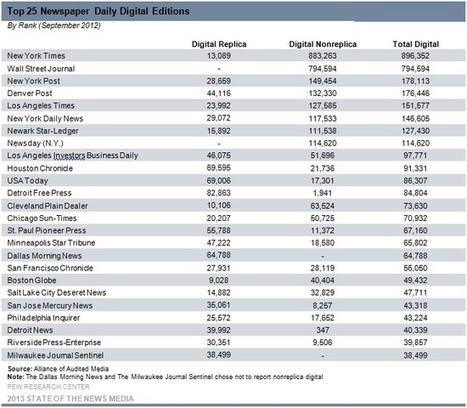

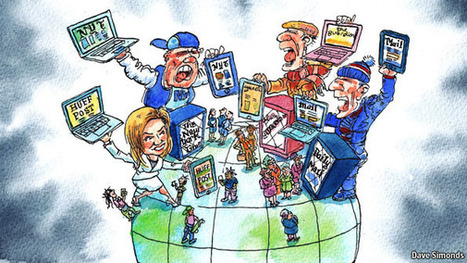





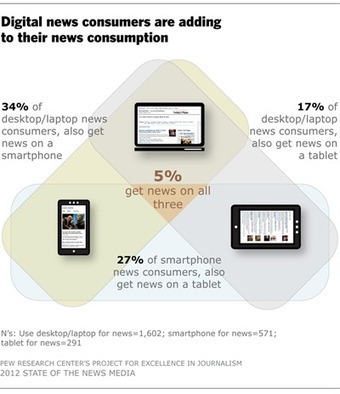
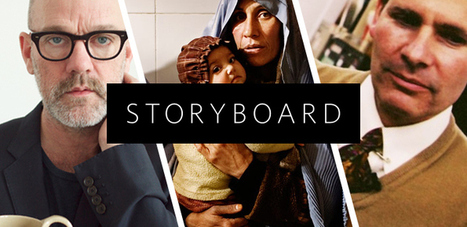










Are newspapers on the way to a comeback with digital subscriptions?